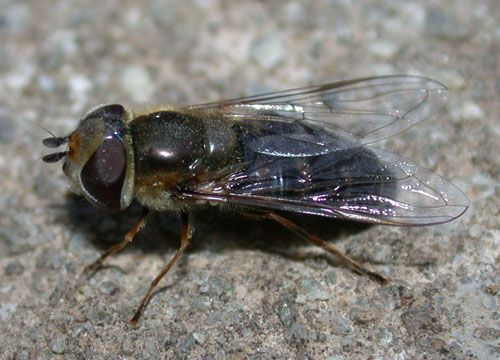Thread subject: Diptera.info :: sirphidae
Posted by gordo on 24-11-2004 15:06
#1
hello,
I think this sirphidae is Cheilosa pictipennis, can you confirm my idea.
I see it on september.

Posted by Menno Reemer on 24-11-2004 15:26
#2
This is a female of
Scaeva selenitica without the characteristic white abdominal markings. This abberation is often called var.
unicolor, and it occurs in females in which the ovaries have not developed properly (possibly because of certain parasites).
The specimen is recognizable as a
Scaeva species by the swollen frons and the S-curved wing vein r4+5.
Cheilosia species do not usually have a yellow scutellum and face.
Posted by Paul Beuk on 24-11-2004 15:38
#3
I agree with Menno that it appears to be
selenitica, but officially the form name
unicolor is described for
S. pyrastri and treated as synonym for that species.
Females with ovaries have been described for many more species and no doubt the phenomenon will occur in
selenitica as well. In some of those species these 'females' are considered to be intersexes because they have intermediate characters between males and females and no developed genital structures. The intermediacy is especially clear in species of
Platycheirus and
Pyrophaena. In other species it usually appears as if the frons is narrower than in ordinary females.
In your specimen the frons does not really seems to be narrower, and since vague markings are visible (though much darker than normal) I am not yet convinced that this is a true '
unicolor'-like specimen.
For '
unicolor's also see images linked on
http://www.bioima...R38418.HTM.
Posted by Steve Crellin on 24-11-2004 16:31
#4
I don't doubt that the i.d of S. selentica is correct, baring in mind who has provided it, but what is it about this specimen that says "selentica" as opposed to "pyrastri"?
Generally, I would be relying on the differences in the abdominal markings between the two species, but in the case of this specimen these markings are not really available. Its always useful to know of other characters to use.
Edited by Steve Crellin on 24-11-2004 16:33
Posted by Menno Reemer on 24-11-2004 16:49
#5
Oops, I accidentily wrote
'selenitica', but of course I meant
pyrastri! Sorry for this mistake. There are two old papers by Van Doesburg which deal with this 'var.
unicolor' , and he found several specimens of this abberation with incompletely developed ovaries. I do not have the references of these papers here, but I will let you know later.
Posted by Paul Beuk on 24-11-2004 21:38
#6
The references:
Doesburg Sr., P.H. van, 1964. Bijdrage tot de kennis van het melanisme bij Syrphiden. ? Entomologische Berichten, Amsterdam 24(6): 117-118.
Doesburg Sr., P.H. van, 1970. Female Syrphid flies without ovarium. ? Entomologische Berichten, Amsterdam 30(8): 157-158.
And about the identity: I was serious about the species more reminding me of
S. selenitica than of
S. pyrastri, especially the shape of the (very indistinct) markings. I do not have all the details on other characters here, but if someone has the decider why it
cannot be
S. selenitica, I would be happy to hear.
Posted by Gerard Pennards on 04-12-2004 12:37
#7
In general, if you find a specimen of Scaeva like this, there are other differences on which you can distinguish S. pyrastri from S. selenitica.
Pyrastri has on its sternites bigger, square dark markings, which are broader than high.
With S. selenitica, these markings are more rounded, and these are higher than broad.
Furthermore, selenitica usually has a black ring on the hind tibia, which is absent in pyrastri!
Greetings

